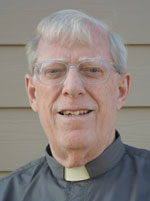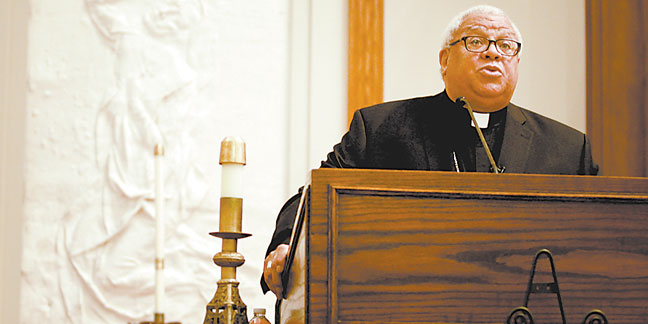 CHARLOTTE — Bishop Peter Jugis announces the appointment of Deacon Clarke E. Cochran to serve St. Peter Church in Charlotte effective Jan. 15.
CHARLOTTE — Bishop Peter Jugis announces the appointment of Deacon Clarke E. Cochran to serve St. Peter Church in Charlotte effective Jan. 15.
From Lubbock, Texas, Deacon Cochran and his wife Anne relocated to Indian Trail to be closer to their grandchildren. Deacon Cochran was ordained on Feb. 14, 1981, for the Diocese of Amarillo by Bishop Leroy Matthieson. When the Diocese of Lubbock was established on June 17, 1983, he was incardinated into the Diocese of Lubbock and held several administrative offices including being appointed the first director of the Permanent Diaconate.
Throughout 37 years of diaconate service, he has given of himself in support of social teachings pertaining to religion, politics, health care policy, and Catholic social doctrine. He has been especially involved in homeless ministry, death penalty abolition and other aspects of charity and justice.
At the parish level, Deacon Cochran and his wife were founding members of St. John Neumann Parish in Lubbock, Texas. This was where he was assigned a deacon in 1981 and where he served until moving to North Carolina.
— Deacon John Martino
 CHARLOTTE — The Church must confront the sin of racism, listen to people who have been oppressed, and seek reconciliation in part by promoting people of color into leadership roles, said the bishop who is in charge of addressing the topic for the Church in the United States.
CHARLOTTE — The Church must confront the sin of racism, listen to people who have been oppressed, and seek reconciliation in part by promoting people of color into leadership roles, said the bishop who is in charge of addressing the topic for the Church in the United States.
Bishop George Murry of Youngstown, Ohio, who chairs the U.S. bishops’ Ad Hoc Committee Against Racism, spoke about racism in the Church’s history and how the committee is addressing it during a Jan. 27 talk at St. Peter Church in Charlotte.
About 350 people attended the 2018 Kennedy Lecture, including members of Our Lady of Consolation Church. The majority black parish near downtown Charlotte has fostered an ongoing dialogue on race with members of St. Peter Church, a majority white parish less than three miles away, in the wake of a fatal police shooting that sparked violent protests in the city in 2016, leaving one Consolation parishioner dead.
Pictured: Bishop George Murry of Youngstown, Ohio, who chairs the U.S. bishops’ Ad Hoc Committee Against Racism, spoke about racism in the Church’s history and how his committee is addressing it during a Jan. 27 talk at St. Peter Church in Charlotte — at 167 years old, the oldest Catholic church in the city. Behind him is a bas-relief depicting St. Katherine Drexel, who gave money to the parish to buy pews, with the caveat that worshipers not be segregated. (Patricia L. Guilfoyle | Catholic News Herald)
Bishop Murry, a Jesuit whose background is in education, summarized Church teaching on racism and inequality, noting that the Church’s teaching on the fundamental dignity of all people has not always been reflected in its actions – especially in the United States, where racism is “deeply rooted.”
Bishop Murry criticized the Church’s lethargic response to racism in America even after the U.S. bishops issued a 1979 pastoral letter on racism, “Brothers and Sisters to Us.”
“When considering the history of racism in the Catholic Church, one cannot help but wonder why, in the United States, there was so little social consciousness among Catholics regarding racism,” he said. “Why does it appear the Church in America is incapable of taking decisive action and incapable of enunciating clear-cut principles regarding racism that have led to a change of attitude?”
“Racism is a sin that divides the human family and violates the fundamental human dignity of those called to be children of the same Father,” Bishop Murry said, and the Church must become “a consistent voice” to eradicate it.
“In his letter to the Ephesians, St. Paul tells us Jesus is our peace. It is by means of His shed blood and broken body that the dividing walls of enmity have been demolished,” the bishop said, referring to Ephesians 2:14. “Today the Catholic Church in America must recognize that Christ wishes to break down the walls created by the evils of racism, whether that evil is displayed publicly for all to see or buried deep in the recesses of our hearts. If not, we are destined for history to continue to repeat itself, and once again the Church will be perceived as a silent observer in the face of racism.”
The U.S. bishops’ Ad Hoc Committee Against Racism, formed last August, aims to address the problem of racism in the Church and the wider community, “and the urgent need for the nation to come together to find solutions,” he said.
He said the committee is working to bring together people of various races, faiths, cultures and backgrounds – and then listening to them.
On Feb. 23, a national summit of religious leaders and others is being convened, he announced. This “ecumenical gathering” will discuss the sin of racism and find ways to build bridges, he said.
Not just Catholics, but all people of good will must work together to improve race relations, he said, because as a general rule Christian leaders “have not been consistent in getting across to our people that every human being is created in the image and likeness of God.”
“Through listening, prayer and meaningful collaboration, I am hopeful that we can find those lasting solutions that we so much need, and to find common ground, where racism will no longer find a place in our hearts or in our society.”
The Ad Hoc Committee Against Racism is also organizing a series of “listening sessions” across the country, Bishop Murry said.
Intended to be a “national conversation on race,” these sessions will take place in parishes, schools, seminaries, Catholic Charities organizations, Catholic health associations and social service agencies – “in every Catholic organization throughout the country,” he said.
“The goal will be to allow people to listen to each other, to exchange ideas, to become educated and change hearts,” he said, in part by listening closely to people who have experienced prejudice firsthand: African Americans, Latinos, immigrants, Jews and others.
The committee expects to issue a pastoral letter on racism this summer, Bishop Murry said, but that is not its primary focus. Instead, the committee will issue a study guide designed “to encourage people to come together and to overcome their hesitations and their fears, and to talk frankly with each other.”
“There are some people in our country who are not going to want to have anything to do with any discussion about race because they think that they’re OK, it doesn’t affect them, ‘leave me alone,’” he said. “There are other people who are curious and wondering. They’re simply honest people who are saying, ‘I don’t want to oppress anybody. I don’t want to discriminate against anybody. How can I learn how best to be sensitive to other people?’”
The study guide is meant to help people have earnest conversations with each other, he said.
Besides listening and learning, Bishop Murry said, the Church must “break her silence.”
“In imitation of Christ, we the Church must be willing to give our total lives over to the liberation of women and men by defending the dignity and fundamental rights of every human person – and this includes a visible denouncement of racism,” he said.
But beyond statements, he continued, “the Church must seek the forgiveness of those that she has victimized by her past injustices.”
Reconciliation can be fostered by finding ways to include people of color in decision-making and leadership roles within the Church, he said.
The Church must also confront racism wherever it occurs, he said.
The Church must “speak and live in truth,” he said, “leaving behind the comfortable attitudes of superiority and fear. To get to that truth, we must break the silent complicity with the social evil of racism.”
“If race in the Catholic imagination is to exemplify the love of Christ, it must move forward with the realization that no one – no one – can enter into full communion with the Lord if his or her relationship is marked by indifference or oppression of others,” he said.
Some people may not feel comfortable talking about racism or “white privilege,” he said, but the Church should not shirk from teaching the truth.
“We have to be realistic in facing the evil of racism. It is deeply rooted in our consciousness, in our history and in our culture. It is not going away overnight,” he said. “What we have to do is chip away at it, with concrete examples of how white privilege factors into our daily lives and how it affects people who are not white.”
“The grace of God is the only thing that can lead us to stand up to the evil one and say, ‘I want to open my eyes and see the truth.’ Some people will be able to do that, some people will not,” Bishop Murry said.
— Patricia L. Guilfoyle, editor
More online
At www.usccb.org/issues-and-action/human-life-and-dignity/racism: Get resources about Church teaching on racism, read the 1979 pastoral letter “Brothers and Sisters to Us,” download prayers and liturgy guides, and more

